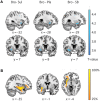Dopaminergic drug effects during reversal learning depend on anatomical connections between the orbitofrontal cortex and the amygdala
- PMID: 23966907
- PMCID: PMC3743215
- DOI: 10.3389/fnins.2013.00142
Dopaminergic drug effects during reversal learning depend on anatomical connections between the orbitofrontal cortex and the amygdala
Abstract
Dopamine in the striatum is known to be important for reversal learning. However, the striatum does not act in isolation and reversal learning is also well-accepted to depend on the orbitofrontal cortex (OFC) and the amygdala. Here we assessed whether dopaminergic drug effects on human striatal BOLD signaling during reversal learning is associated with anatomical connectivity in an orbitofrontal-limbic-striatal network, as measured with diffusion tensor imaging (DTI). By using a fiber-based approach, we demonstrate that dopaminergic drug effects on striatal BOLD signal varied as a function of fractional anisotropy (FA) in a pathway connecting the OFC with the amygdala. Moreover, our experimental design allowed us to establish that these white-matter dependent drug effects were mediated via D2 receptors. Thus, white matter dependent effects of the D2 receptor agonist bromocriptine on striatal BOLD signal were abolished by co-administration with the D2 receptor antagonist sulpiride. These data provide fundamental insight into the mechanism of action of dopaminergic drug effects during reversal learning. In addition, they may have important clinical implications by suggesting that white matter integrity can help predict dopaminergic drug effects on brain function, ultimately contributing to individual tailoring of dopaminergic drug treatment strategies in psychiatry.
Keywords: OFC; amygdala; bromocriptine; diffusion tensor imaging; dopamine; reversal learning; striatum; sulpiride.
Figures



Similar articles
-
Establishing the dopamine dependency of human striatal signals during reward and punishment reversal learning.Cereb Cortex. 2014 Mar;24(3):633-42. doi: 10.1093/cercor/bhs344. Epub 2012 Nov 25. Cereb Cortex. 2014. PMID: 23183711 Clinical Trial.
-
Anatomical connection strength predicts dopaminergic drug effects on fronto-striatal function.Psychopharmacology (Berl). 2013 Jun;227(3):521-31. doi: 10.1007/s00213-013-3000-5. Epub 2013 Feb 13. Psychopharmacology (Berl). 2013. PMID: 23404064 Free PMC article. Clinical Trial.
-
Tract-Specific White Matter Correlates of Age-Related Reward Devaluation Deficits in Macaque Monkeys.J Neuroimaging Psychiatry Neurol. 2018;3(2):13-26. doi: 10.17756/jnpn.2018-023. Epub 2018 Jul 19. J Neuroimaging Psychiatry Neurol. 2018. PMID: 30198011 Free PMC article.
-
Striatal dopamine predicts outcome-specific reversal learning and its sensitivity to dopaminergic drug administration.J Neurosci. 2009 Feb 4;29(5):1538-43. doi: 10.1523/JNEUROSCI.4467-08.2009. J Neurosci. 2009. PMID: 19193900 Free PMC article. Clinical Trial.
-
Stimulant treatment history predicts frontal-striatal structural connectivity in adolescents with attention-deficit/hyperactivity disorder.Eur Neuropsychopharmacol. 2016 Apr;26(4):674-83. doi: 10.1016/j.euroneuro.2016.02.007. Epub 2016 Feb 10. Eur Neuropsychopharmacol. 2016. PMID: 26899587
Cited by
-
Role of dopamine D2 receptors in optimizing choice strategy in a dynamic and uncertain environment.Front Behav Neurosci. 2014 Oct 28;8:368. doi: 10.3389/fnbeh.2014.00368. eCollection 2014. Front Behav Neurosci. 2014. PMID: 25389395 Free PMC article.
-
Early Life Stress Drives Sex-Selective Impairment in Reversal Learning by Affecting Parvalbumin Interneurons in Orbitofrontal Cortex of Mice.Cell Rep. 2018 Nov 27;25(9):2299-2307.e4. doi: 10.1016/j.celrep.2018.11.010. Cell Rep. 2018. PMID: 30485800 Free PMC article.
-
A kinder, gentler dopamine… highlighting dopamine's role in behavioral flexibility.Front Neurosci. 2014 Jan 24;8:4. doi: 10.3389/fnins.2014.00004. eCollection 2014. Front Neurosci. 2014. PMID: 24478624 Free PMC article. No abstract available.
-
Syn3 Gene Knockout Negatively Impacts Aspects of Reversal Learning Performance.eNeuro. 2021 Sep 9;8(5):ENEURO.0251-21.2021. doi: 10.1523/ENEURO.0251-21.2021. Print 2021 Sep-Oct. eNeuro. 2021. PMID: 34413083 Free PMC article.
-
Effects of methamphetamine on human effort task performance are unrelated to its subjective effects.Psychopharmacology (Berl). 2025 Jul 8. doi: 10.1007/s00213-025-06853-4. Online ahead of print. Psychopharmacology (Berl). 2025. PMID: 40627130
References
LinkOut - more resources
Full Text Sources
Other Literature Sources

